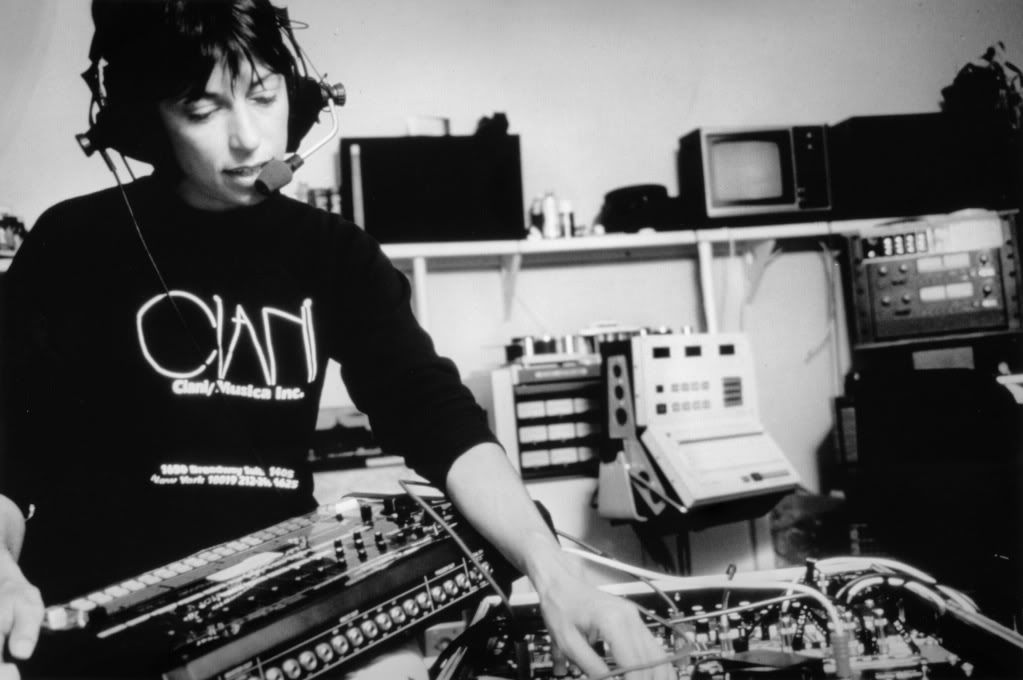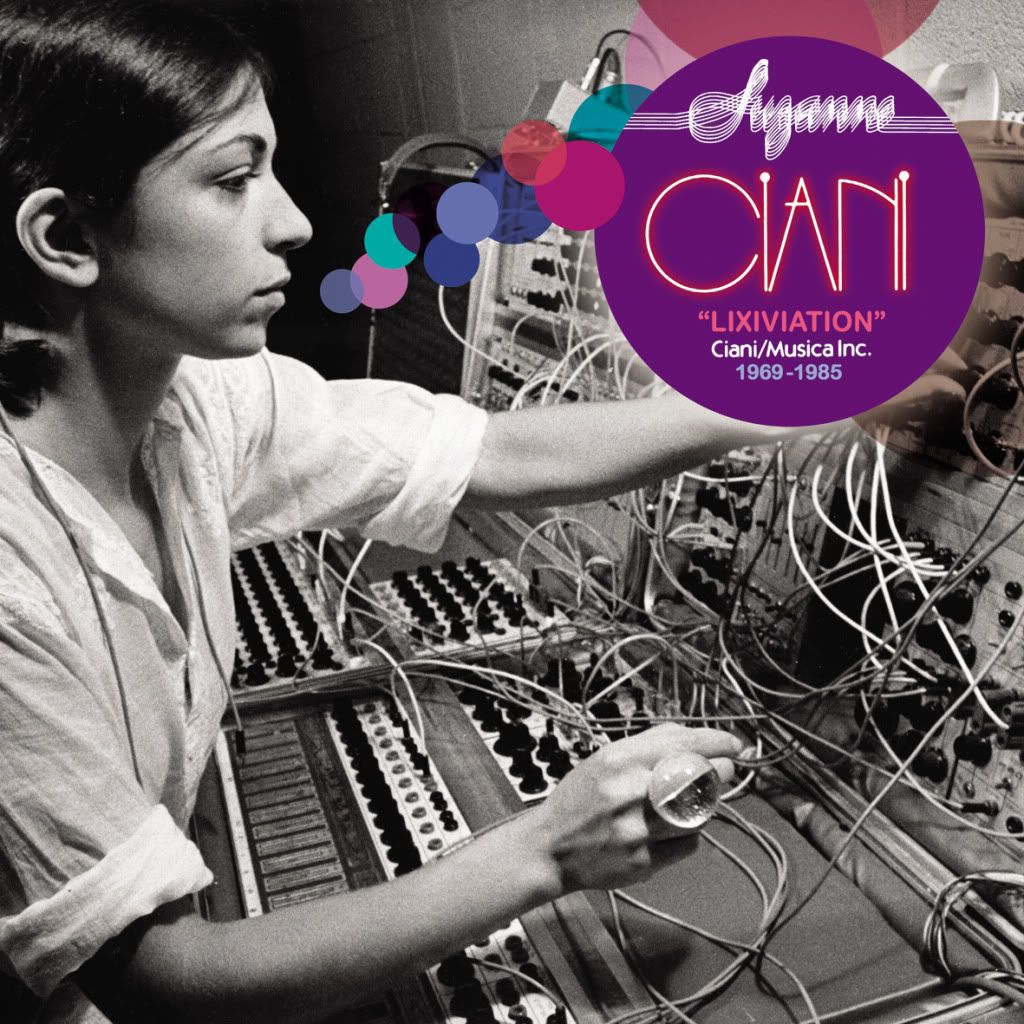
An intriguing and historically significant retrospective of
unreleased material from electronic music pioneer Suzanne Ciani,Lixiviation, due February
28 on B-Music/ Finders Keepers Records, is a
fascinating compilation of unearthed gems from one of electronic music's
earliest innovators. Spanning nearly two decades from 1968-1985 the 16-track
album celebrates Ciani's formative years as a musician as it showcases her
early synth compositions alongside her cutting edge commercial work for such
companies as Atari, PBS, Ballys and Coca-cola. Lixiviation comes
as the result of a new creative archive based relationship between
B-Music/Finders Keepers Records and Suzanne Ciani.
Ciani's detailed and academic approach to music and
electronics coupled with an impeccable sense of timing and melody (and a good
sense of humor) shines throughout this new collection of previously unreleased
recordings. Lixiviation compiles and re-contextualizes both
secret music and commercial experiments of Ciani made for microcosmic time
slots and never previously documented on vinyl or CD. The album oscillates
between Ciani's early experimental electronic compositions and a variety of
commercial works. There's her famous "Pop & Pour" for Coca-Cola,
scores for ITT and Almay commercials, and the Atari video games logo and
corporate tag. There's also the Kraftwerk-esque TV spot for Atari's
"Liberator." Interspersed through the compilation is a variety of
ultra rare synth experiments, ranging from the otherworldly hums and
arpeggiated synth lines of title track "Lixiviation" to the bubbling
dreamscape of "Princess with Orange Feet" and the nine-minute ambient
finale of "Second Breath."
Labeled the "American Delia Derbyshire of the Atari
generation," Ciani was a trailblazer in the fields of electronic music,
synthesizers and sound design and one of the first women to make a name for
herself in the male dominated world of electronic music. In an era when most
musicians were enamored with rock and roll and electric guitars, Ciani was
transfixed by the endless possibilities of synthesizers. She would go on to
have a sonic portfolio boasting commissions for the Xenon classic pinball
machine, the sounds for the Meco Star Wars theme, the Atari TV commercials and
the electronic sound effects in the original "Stepford Wives" film
(amongst many others) in addition to her personal compositions - some of the
most unique and experimental music of its time. Ciani would find great success
both commercially and artistically: She was profiled by the New York
Times in 1974, featured on "The David Letterman Show" in
1980 where she demonstrated her synthesizers to a bewildered Letterman, had the
#1 sound design music house in New York, and would become the first solo female
composer of a major Hollywood film when she scored Lily Tomlin's "The
Incredible Shrinking Woman."
A classically trained musician with an MA in music
composition this American Italian pianist had her roots in both digital and analog
synthesis from the beginning. She studied at Stanford with Max Mathews, the
father of computer music, and John Chowning, the father of digital frequency
modulation and was first introduced to the synthesizer via her connections in
the art world when abstract sculptor and collaborator Harold Paris introduced
Ciani to synthesizer designer Don Buchla who created the instrument that would
come to define Ciani's synthetic sound - the Buchla Synthesizer. As
one of the very few female composers in the field (save Chicago's Laurie
Spiegel, Italy's Doris Norton, and a post-op Walter Wendy Carlos) Ciani turned
a hugely significant wheel behind-the-screens of many early computerized music
modules throughout the 1980's dating back to her formative years studying at
Stanford's Artificial Intelligence Labs in the early '70s.
Cutting her teeth providing self-initiated electronic music
projects for art galleries, experimental film directors, and pop record
producers Ciani soon located to New York where she quickly became the go-to for
electronic music services in both the underground experimental fields and the
commercial advertising worlds alike. In 1974 she formed her own company Ciani/Musica
and composed music for television commercials for Coca-Cola, Atari, Merrill
Lynch, General Electric and Clairol, using a Buchla analog modular synthesizer.
Besides music, her specialty was reproducing sound effects on the synthesizer
that recording engineers found difficult to record properly; the sound of a
bottle of Coke being opened and poured ("Pop & Pour") was one of
her most widely recognized works, and was used in a series of radio and
television commercials in the late 1970s. Counting names like Vangelis and
Harald Bode amongst her close friends Ciani and her company became the testing
ground for virtually any type of new developments in electronic and
computerized music. She amassed an expansive vault of commercially unexposed
electronic experiments which have remained untouched for over 30 years... until
now.
This is the first sneak peek of the early Ciani metal music
and non-pop that later went on to see her nominated for multiple Grammy awards
for her later achievements which brought synthesizer music to the new age
movement.

Suzanne Ciani
Lixiviation
(B-Music/Finders Keepers Records)
Release Date: February 28, 2012
1. Lixiviation
2. Atari Video Games Logo
3. "Clean Room" ITT TV Spot
4. Almay "Eclipse" TV Spot
5. Paris 1971
6. Sound of a Dream Kissing
7. Atari Corporate Tag
8. Princess With Orange Feet
9. "Pop & Pour" Coca-Cola Logo
10. "Discover Magazine" TV Spot
11. Live Buchla Concert 1975
12. "Inside Story" PBS TV Spot
13. "Liberator" Atari TV Spot
14. Eighth Wave
15. Sound of Wetness
16. Second Breath

No comments:
Post a Comment